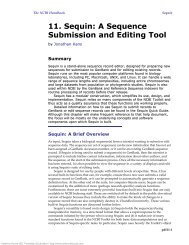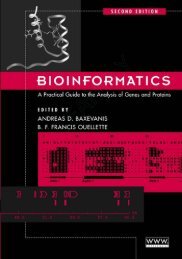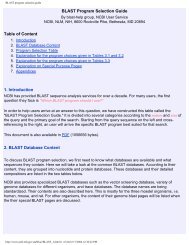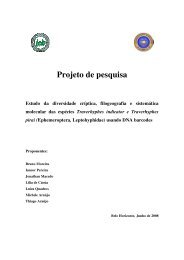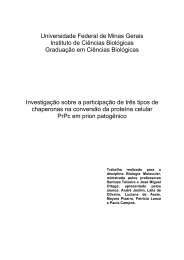1. GenBank: The Nucleotide Sequence Database
1. GenBank: The Nucleotide Sequence Database
1. GenBank: The Nucleotide Sequence Database
Create successful ePaper yourself
Turn your PDF publications into a flip-book with our unique Google optimized e-Paper software.
Antenna House XSL Formatter (Evaluation) http://www.antennahouse.com<br />
<strong>The</strong> NCBI Handbook<br />
<strong>GenBank</strong><br />
What defines a set Environmental sample, population, phylogenetic, and mutation<br />
sets all contain a group of sequences that spans the same gene or region of the genome.<br />
Environmental samples are derived from a group of unclassified or unknown organisms.<br />
A population set contains sequences from different isolates of the same organism. A<br />
phylogenetic set contains sequences from different organisms that are used to determine<br />
the phylogenetic relationship between them. Sequencing multiple mutations within a<br />
single gene gives rise to a mutation set.<br />
All sets, except segmented sets, may contain an alignment of the sequences within<br />
them and might include external sequences already present in the database. In fact, the<br />
submitter can begin with an existing alignment to create a submission to the database<br />
using the Sequin submission tool. Currently, Sequin accepts FASTA+GAP, PHYLIP,<br />
MACAW, NEXUS Interleaved, and NEXUS Contiguous alignments. Submitted<br />
alignments will be displayed in the PopSet section of Entrez.<br />
Segmented sets are a collection of noncontiguous sequences that cover a specified<br />
genetic region. <strong>The</strong> most common example is a set of genomic sequences containing<br />
exons from a single gene where part or all of the intervening regions have not been<br />
sequenced. Each member record within the set contains the appropriate annotation, exon<br />
features in this case. However, the mRNA and CDS will be annotated as joined features<br />
across the individual records. Segmented sets themselves can be part of an environmental<br />
sample, population, phylogenetic, or mutation set.<br />
Bulk Submissions: High-Throughput Genomic<br />
<strong>Sequence</strong> (HTGS)<br />
HTGS entries are submitted in bulk by genome centers, processed by an automated<br />
system, and then released to <strong>GenBank</strong>. Currently, about 30 genome centers are submitting<br />
data for a number of organisms, including human, mouse, rat, rice, and Trypanosoma<br />
brucei, the malaria parasite.<br />
HTGS data are submitted in four phases of completion: 0, 1, 2, and 3. Phase 0<br />
sequences are one-to-few reads of a single clone and are not usually assembled into<br />
contigs. <strong>The</strong>y are low-quality sequences that are often used to check whether another<br />
center is already sequencing a particular clone. Phase 1 entries are assembled into contigs<br />
that are separated by sequence gaps, the relative order and orientation of which are not<br />
known (Figure 1). Phase 2 entries are also unfinished sequences that may or may not<br />
contain sequence gaps. If there are gaps, then the contigs are in the correct order and<br />
orientation. Phase 3 sequences are of finished quality and have no gaps. For each<br />
organism, the group overseeing the sequencing effort determines the definition of<br />
finished quality.<br />
Figure 1:<br />
Diagram showing the orientation and gaps that might be expected in high-throughput sequence from phases 1,<br />
2, and 3.<br />
pdf1-3




